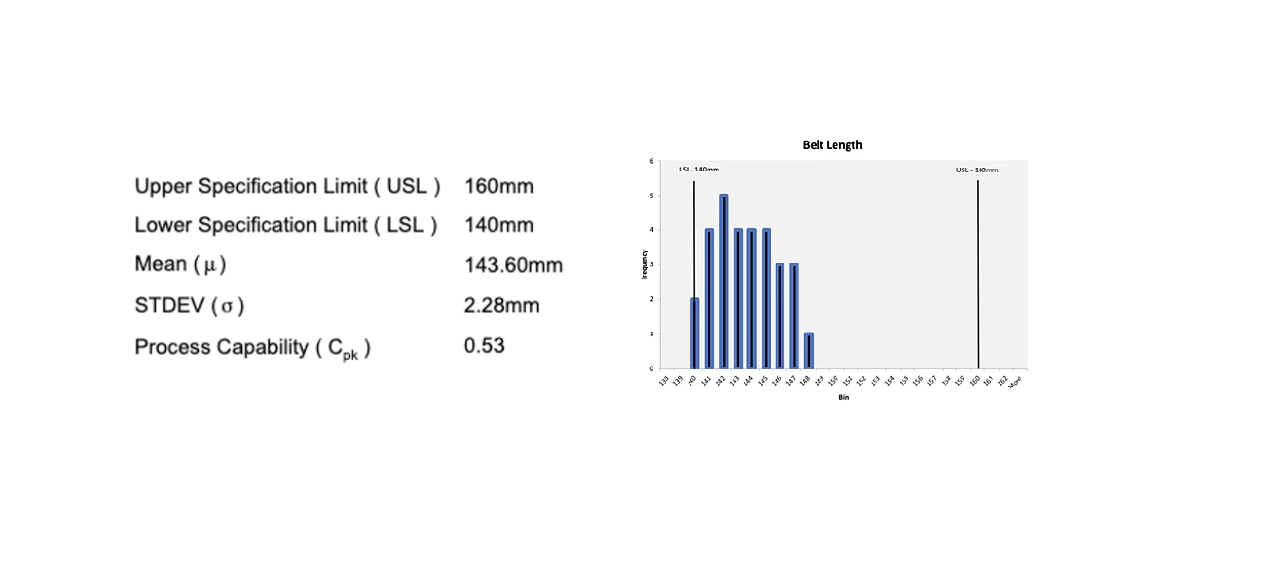When manufacturers assess suppliers, there's a tension between trust and verification. Too often, procurement teams accept first-article samples at face value—and that can lead to serious failures downstream.
A Real-World Example: The Drive Belt that Almost Failed Us
Early in my career, managing supplier and quality for a consumer electronics company, I encountered a classic trap. We were sourcing a drive belt—a deceptively simple component that transferred torque from a motor to a brush-roll. But because it rotated at high RPM and demanded precise tension, any deviation in length could kill performance or reliability.
We chose a new supplier and required a first article inspection (FAI): 30 samples to confirm compliance with a spec of 150 mm ± 10 mm. The delivered belts "passed"—but something nagged at me. All the lengths clustered near the lower spec boundary. Why not a balanced mix?
When I ran a statistical analysis, the answer became obvious. The process' Cpk (capability index adjusted for offset) was barely above 0.5, implying ~11% defect rate if the line operated at that level. In reality, the supplier had likely hand-picked the samples that "passed" for the FAI, omitting the failures. When we confronted them, they adjusted the mean length upward and established a stable, centered process. The line ran reliably thereafter.
That experience taught me a vital lesson: verifying compliance once is not enough. You must ensure the supplier's process is capable—and you must guard against sample bias.

Why First Article Isn't Enough
Here's where many companies go off track:
- Spec compliance ≠ stable process. A supplier can produce a few "good" parts while operating an uncontrolled process.
- Mean-shift risk. A distribution skewed toward one spec boundary increases the risk of defects creeping in.
- Sample selection bias. Without oversight, suppliers may discard nonconforming units from the FAI pool.
- Scaling risk. A process that passes on 30 units may fail when operating at volume.
The Power of Capability Indices
In quality engineering, Cp measures how tight a process' spread is relative to tolerance, while Cpk adjusts for mean shift. A Cpk of 1.0 means even with shift, the process stays within spec; below that, defects grow rapidly.
By demanding that new suppliers submit capability studies—beyond simple FAI—you shift the conversation from "Do you occasionally meet spec?" to "Can you robustly stay in spec over time?"
Best Practices for Capability-Driven Supplier Qualification
Here's a playbook:
- Define capability thresholds up front. State minimum acceptable Cp and Cpk values in your supplier quality plans.
- Require representative run data. Ask for 25–30 consecutive parts (or more) under typical production conditions, not idealized settings.
- Audit the sample collection. Where possible, deploy a trusted field engineer or quality auditor to witness the FAI in situ.
- Perform statistical diagnostics. Look not only at mean and sigma, but at skewness and sample truncation (e.g., missing outliers).
- Track capability over time. Incorporate SPC (statistical process control) monitoring once production begins.
- Escalate when capability erodes. If you observe sustained drift, trigger remediation or replacement.
Strategic Upside: Risk Mitigation & Supplier Maturity
By shifting from acceptance to capability, you gain:
- Lower defect rate and rework costs. You catch weak performance before ramp-up.
- Predictable quality performance. You can model defect exposure over time.
- Better supplier alignment. You encourage supplier investment in process control, reducing variability.
- Stronger supply chain trust. Trust is reinforced by data, not anecdotes.
The Bottom Line
"Trust but verify" is more than a proverb—it's a strategic imperative in high-stakes manufacturing. As supply chains globalize and complexity intensifies, superficial validations won't suffice. To protect your brand, cost structure, and reputation, you must drive discipline into supplier qualification with robust statistical capability—and you must detect attempts to game the system.
When data speaks, listen. Let the numbers decide whom you trust.
